Physical Address
304 North Cardinal St.
Dorchester Center, MA 02124
This chapter will discuss congenital anomalies of the elbow. Any congenital abnormality must be assessed and treated with consideration for the remainder of the upper extremity, as well as the generalized condition of the patient and associated medical diagnoses.
Classification may be made according to etiology or phenotypic presentation; the abnormality may be isolated, in association with other upper extremity abnormalities, or as part of a systemic disease or syndrome. Congenital proximal radioulnar synostosis is an example of a congenital condition that can be classified in many ways. It is commonly an isolated abnormality; however, it may be familial, seen in conjunction with other congenital anomalies, or associated with a syndromic presentation.
Often the most difficult problem is to decide whether the presenting deformity is entirely congenital, posttraumatic, developmental, or a combination thereof.
Congenital refers to a primary abnormal formation of the structure of the elbow, resulting in an observed deformity ( Fig. 26.1 ). Other congenital anomalies or a familial history of similar anomalies helps confirm a congenital etiology. Developmental differences refer to elbow skeletal structures that are relatively normal at birth but then secondarily become deformed by abnormal stresses, paralysis, or other limited motion; neural, metabolic, endocrine, or dyscrasia disturbances; tumor or hamartomatous involvement; and disease processes directly affecting the elbow ( Fig. 26.2 ). Because so much of the elbow is cartilaginous at birth, it is difficult to assess and to rule out trauma as a possible agent in some dislocations and deformities. In addition, infections, tumors (congenital or infantile), and systemic diseases may involve the elbow and may simulate a congenital anomaly ( Fig. 26.3 ).
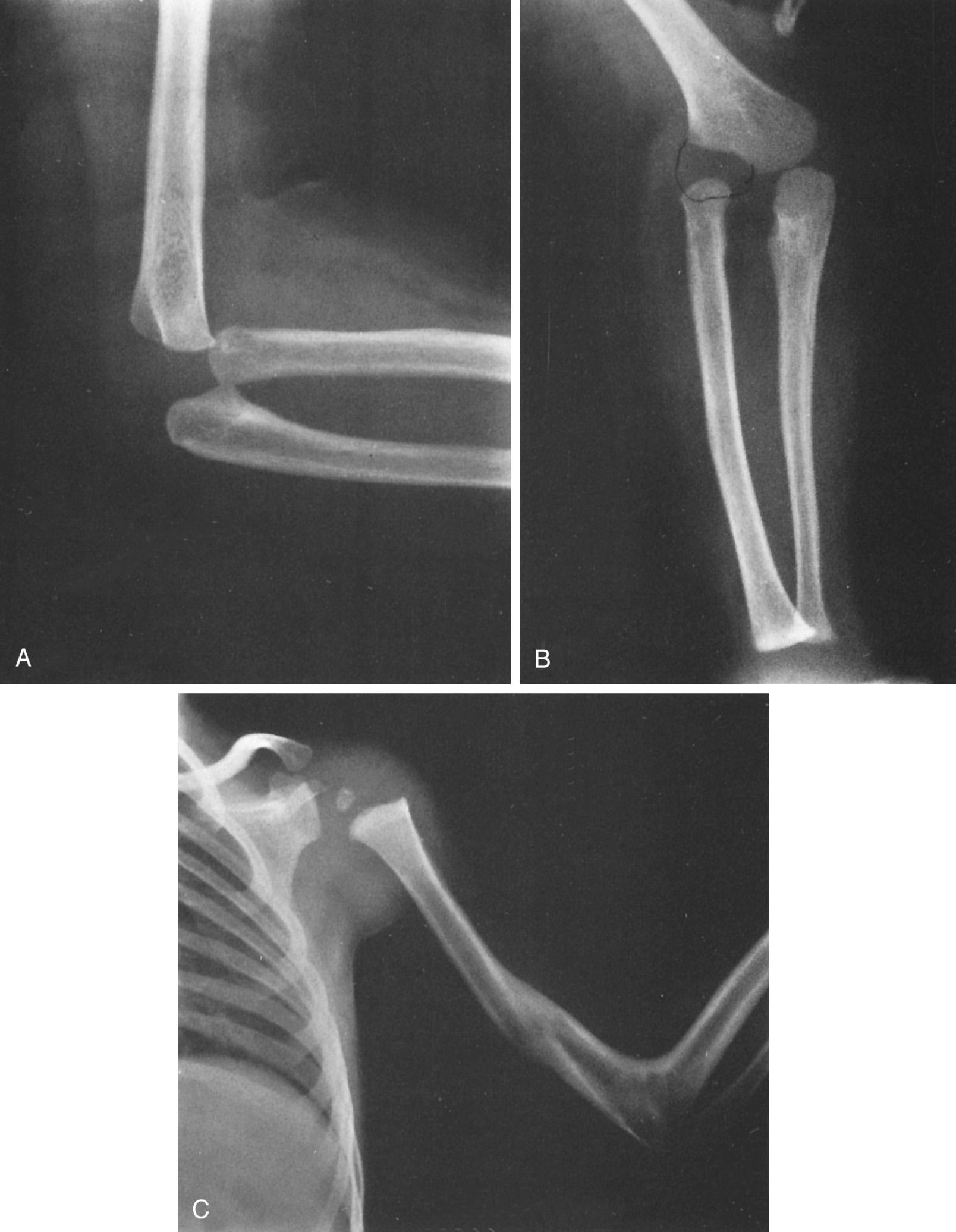
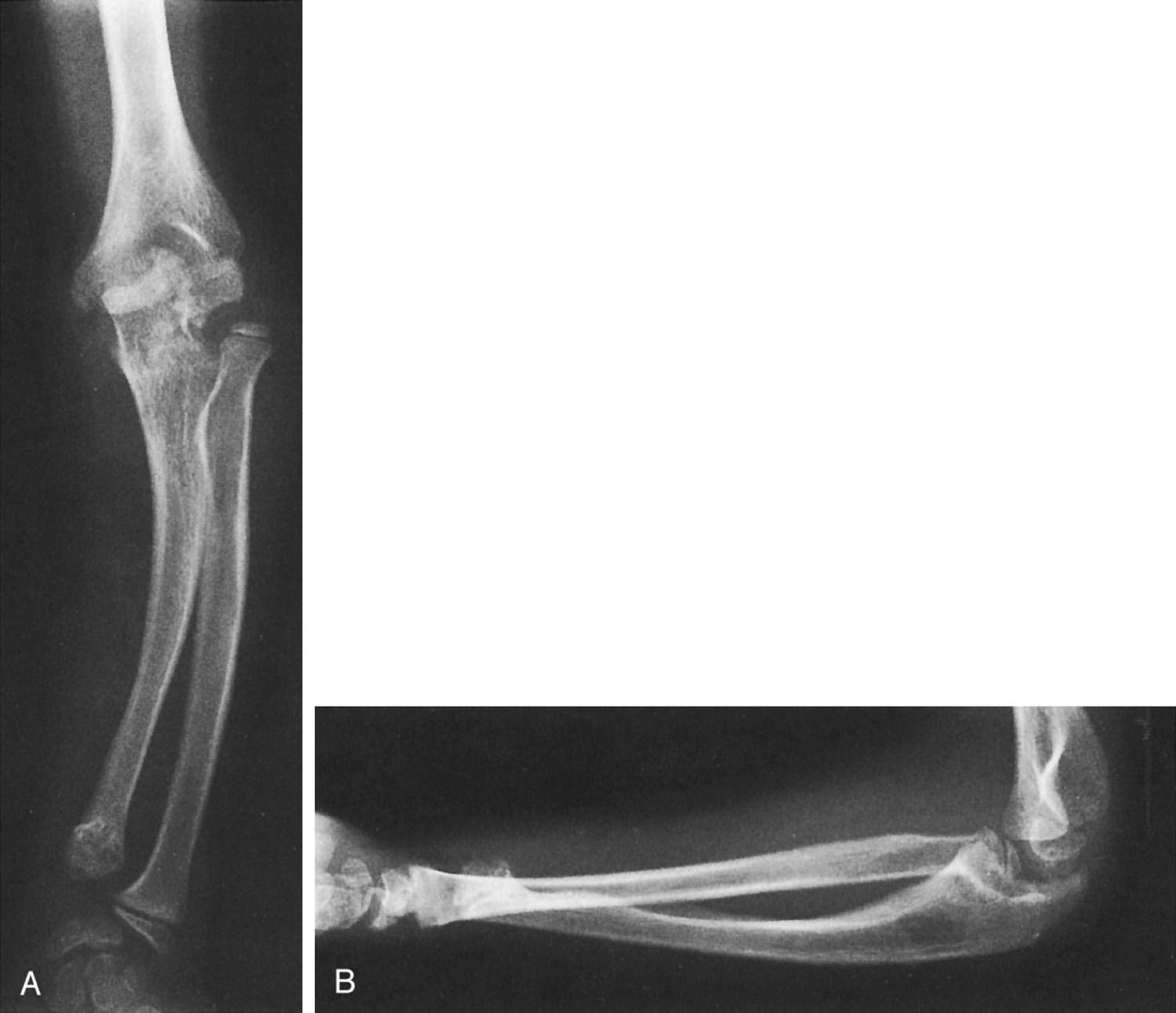
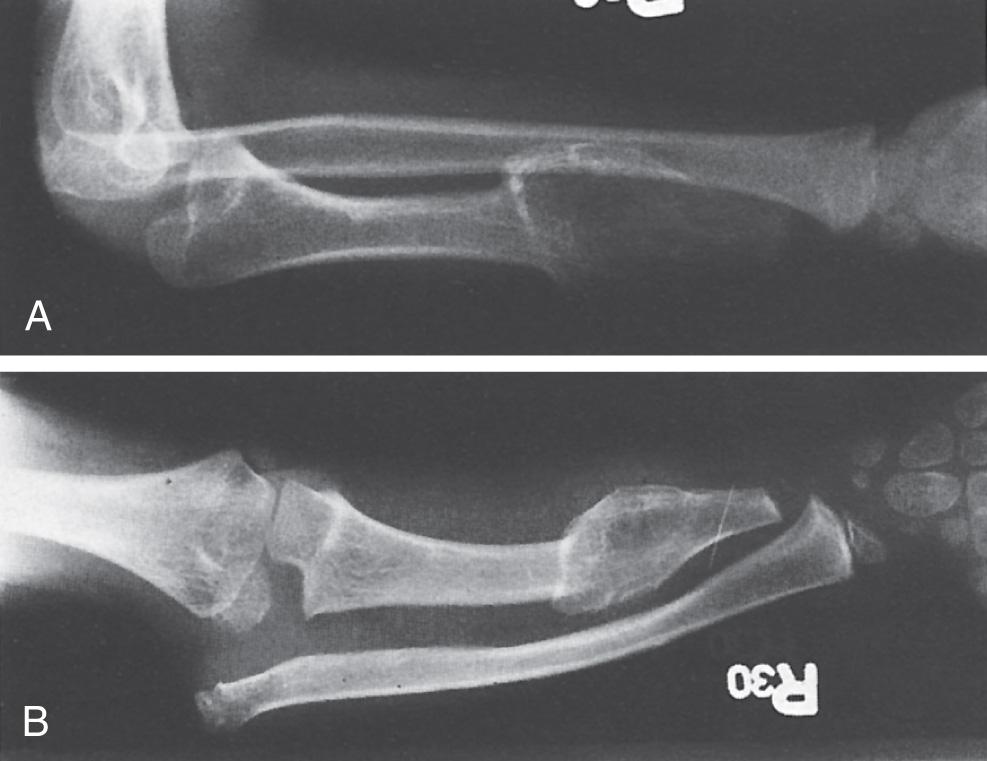
The most common condition in which etiologic classification difficulty arises is subluxation or dislocation of the radial head, which may be congenital, developmental, or posttraumatic. If it is not present at birth, it may be induced by a relatively trivial injury or by a short or deformed ulna from any cause.
The confusions highlighted by classification have been much discussed in the literature. a
a References .
From a practical standpoint, it is most useful to classify congenital abnormalities according to the tissue(s) most affected and the way in which they are affected. Some degree of involvement of the other tissues is also commonly noted.
The classification consists of three major categories: (1) bone and joint anomalies, (2) soft tissue anomalies, and (3) anomalies involving all tissues.
Bone and joint abnormalities at the elbow may include major absences; however, more commonly the skeletal structures are present but malformed. The common bone and joint problems are synostosis, ankyloses ( Fig. 26.4 ), and instability.
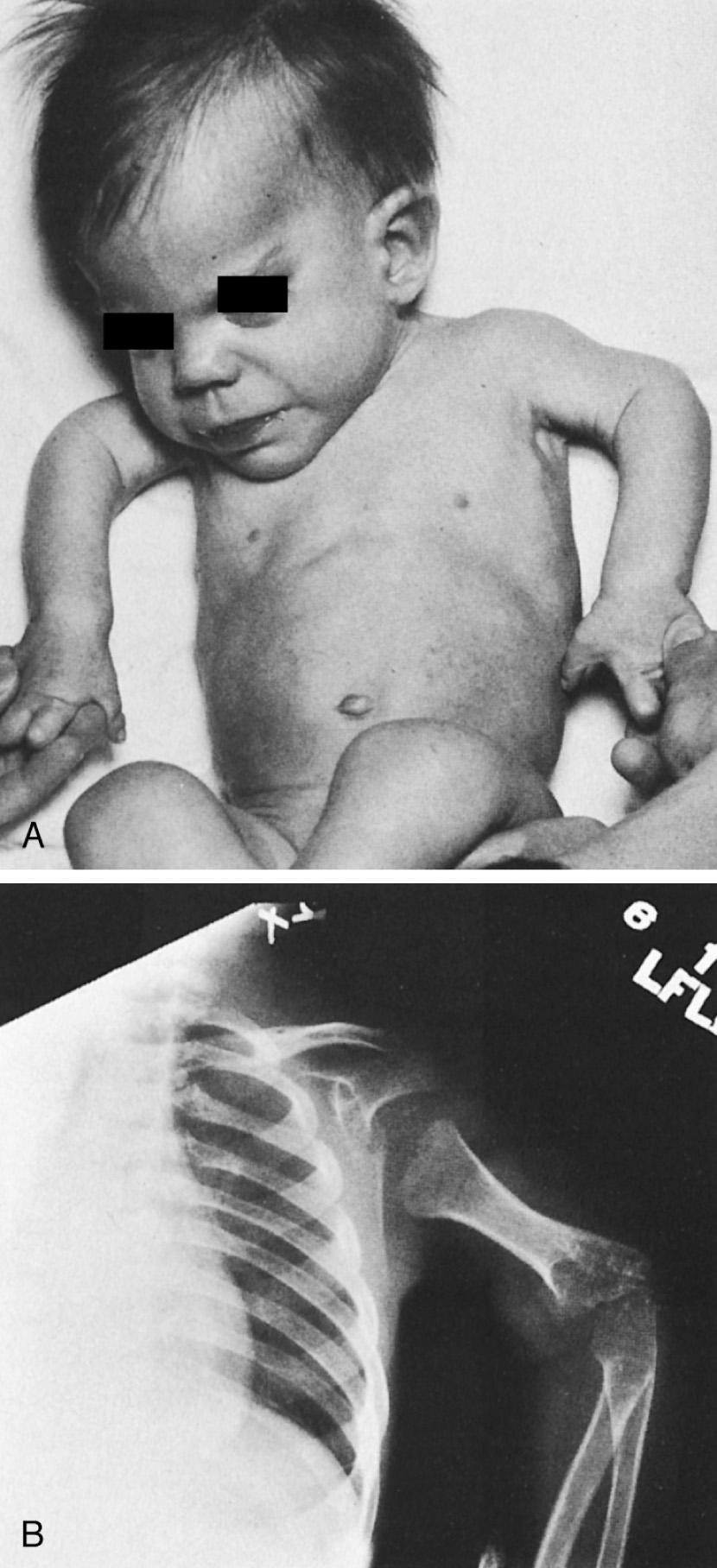
Soft tissue anomalies include malformations with contractures or control deficiencies, isolated tissue anomalies ( Fig. 26.5 ), and congenital tumors ( Fig. 26.6 ).
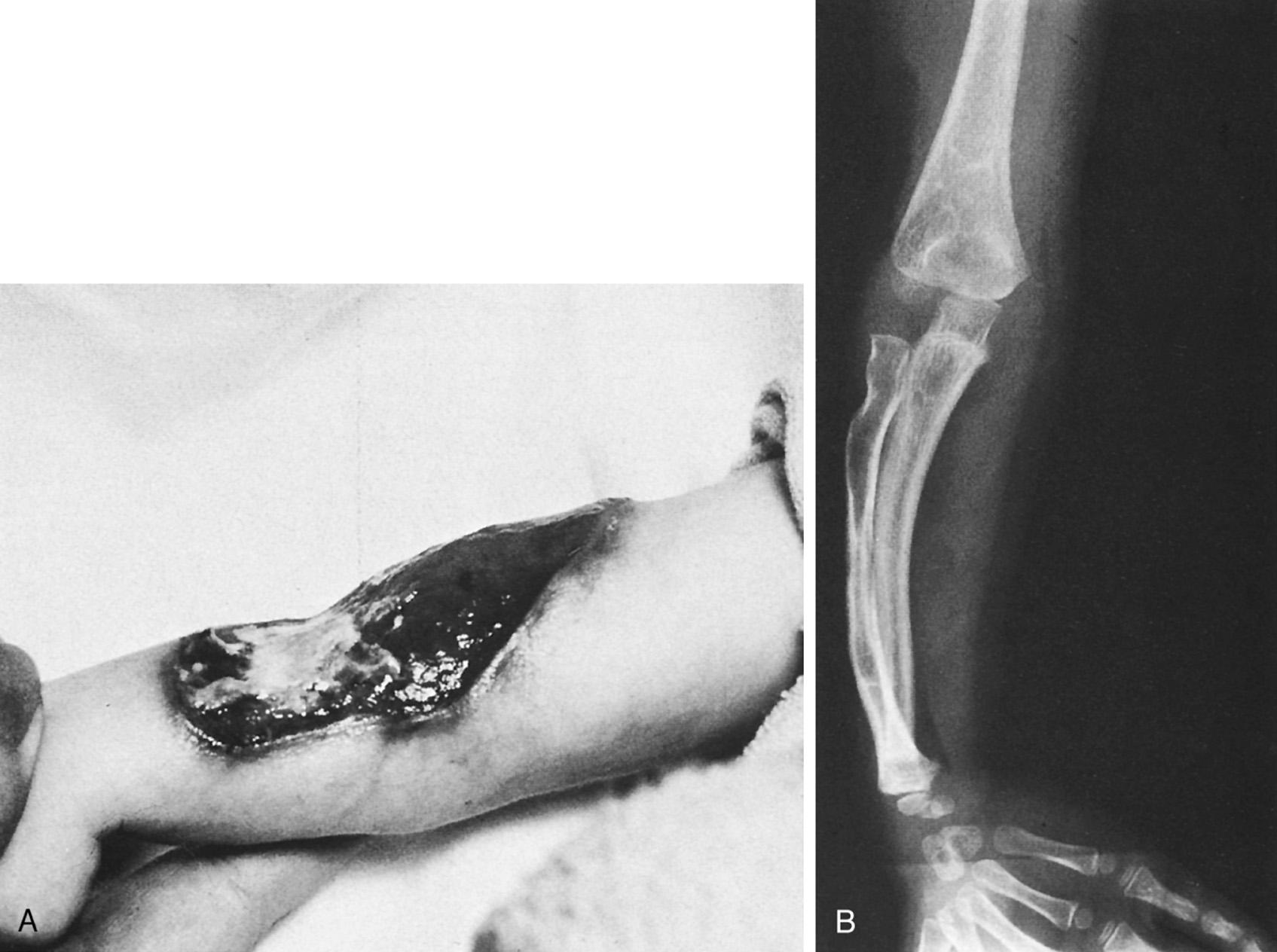
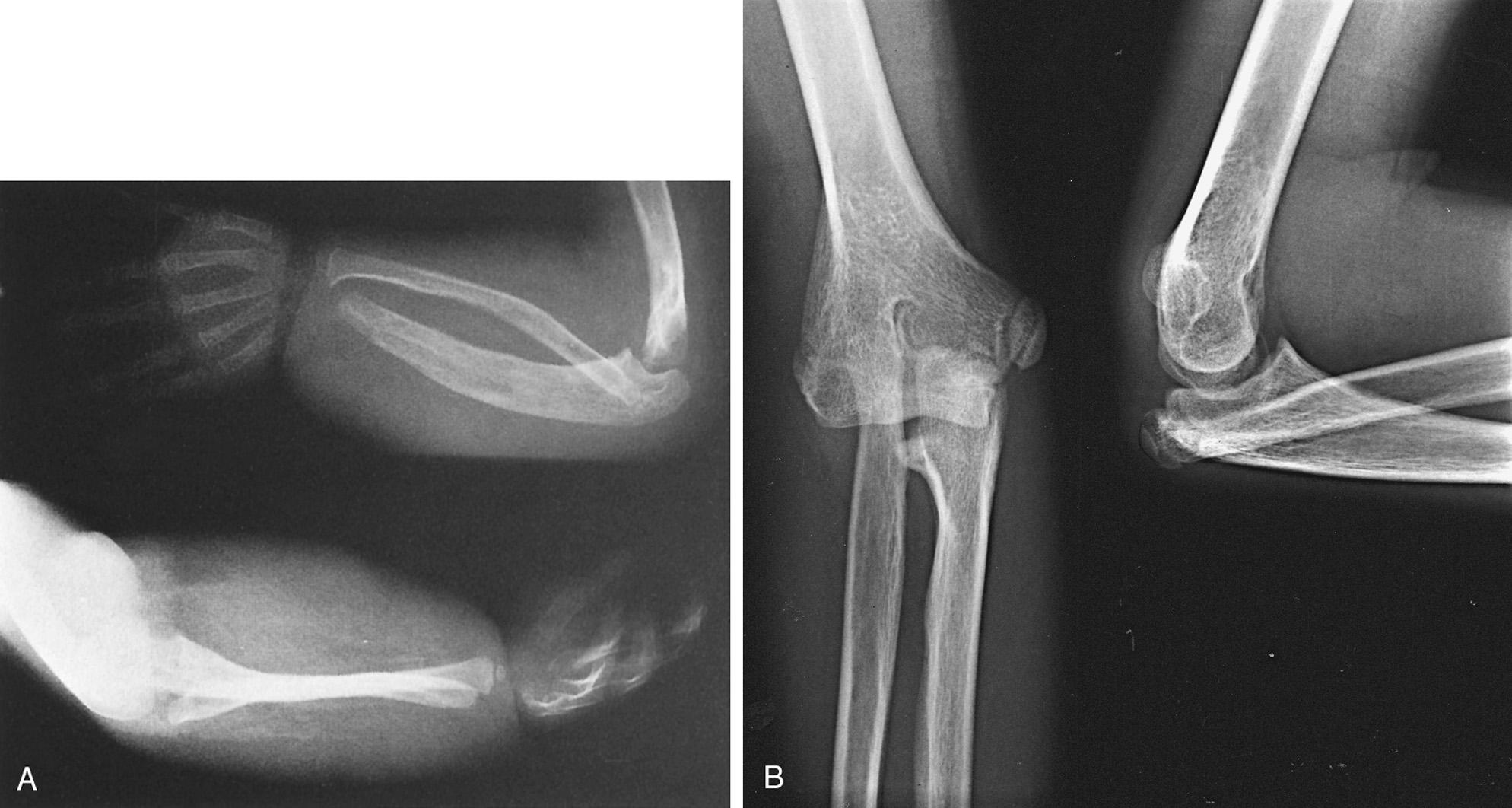
Genetic conditions that commonly involve the elbow are constitutional diseases of bone, metabolic abnormalities, and syndromes featuring limb formation and differentiation failures. An excellent source of reference information is the Online Mendelian Inheritance in Man (OMIM; http://www.omim.org ; McKusick-Nathans Institute of Genetic Medicine, Johns Hopkins University). This database is the result of collaboration among the National Library of Medicine, National Center for Biotechnology Information, and William H. Welch Medical Library at Johns Hopkins University. There are more than 350 conditions associated with differences about the elbow.
Synostoses may occur between all or any two of the bones present at the elbow. The most common synostosis is that between the radius and the ulna proximally near the elbow ( Fig. 26.7A ); however, they also may be joined for a variable distance along their course in the forearm (see Fig. 26.7B ). Radioulnar synostoses result in impaired forearm rotation. Cleary and Omer developed the most widely used classification scheme, in which type I is clinically but not radiographically fused with a reduced normal-appearing radial head; type II is similar but with a clear radiographic bony synostosis; type III has a hypoplastic posteriorly dislocated radial head; and type IV has a hypoplastic anteriorly dislocated radial head. Type III is the most common deformity and the one most likely to be associated with significant rotational deformity (almost always pronation). Radioulnar synostosis is commonly an isolated abnormality, though Cleary and Omer reported 20% of patients have a family history. Simmons found a third had additional congenital anomalies, some with syndromic presentations.
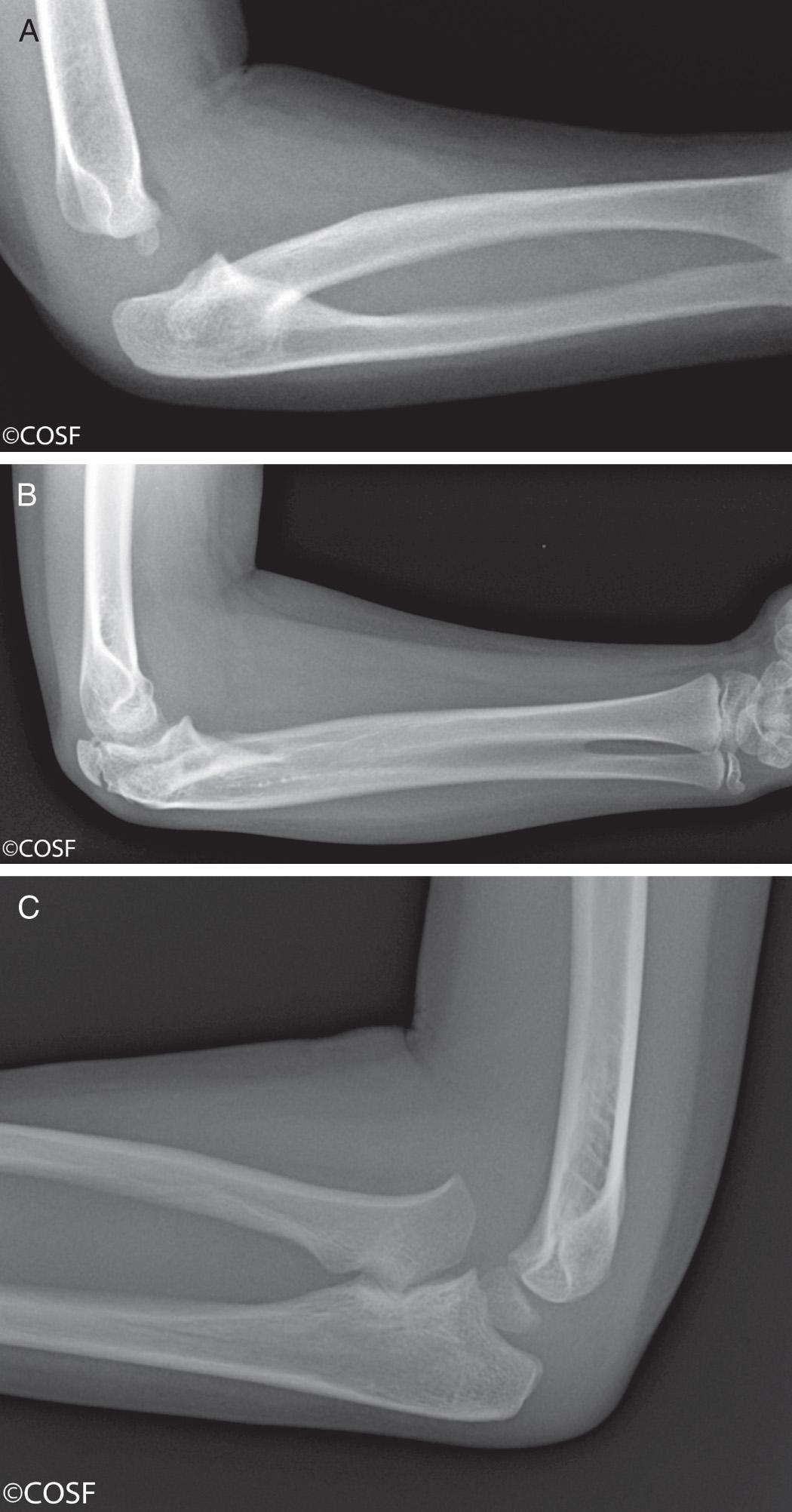
Radiographically incomplete synostosis may also occur (see Fig. 26.7C ), but often, complete bony synostosis forms by maturity. Cleary and Omer's five cases of type I, incomplete radioulnar synostosis are, however, genuine; all of the patients were skeletally mature at the time of final clinical and radiologic review.
Partial ankylosis of the elbow or the proximal radioulnar joint is often overlooked because limited elbow-forearm motion is common in infancy. A failure to improve by school age should raise suspicion. Many children with a partial or complete radioulnar synostosis will compensate and only come to attention when specific sporting or school activities accentuate the difference in movement.
Synostosis between the humerus and either the radius, ulna, or both is far less common and impairs flexion and extension. Of these, the humeroradial type ( Fig. 26.8A ) is most common, followed by humeroradioulnar (see Fig. 26.8B and C ) and humeroulnar types. Often, the synostosis is in association with other limb abnormalities, the most common of which is ulnar longitudinal deficiency.
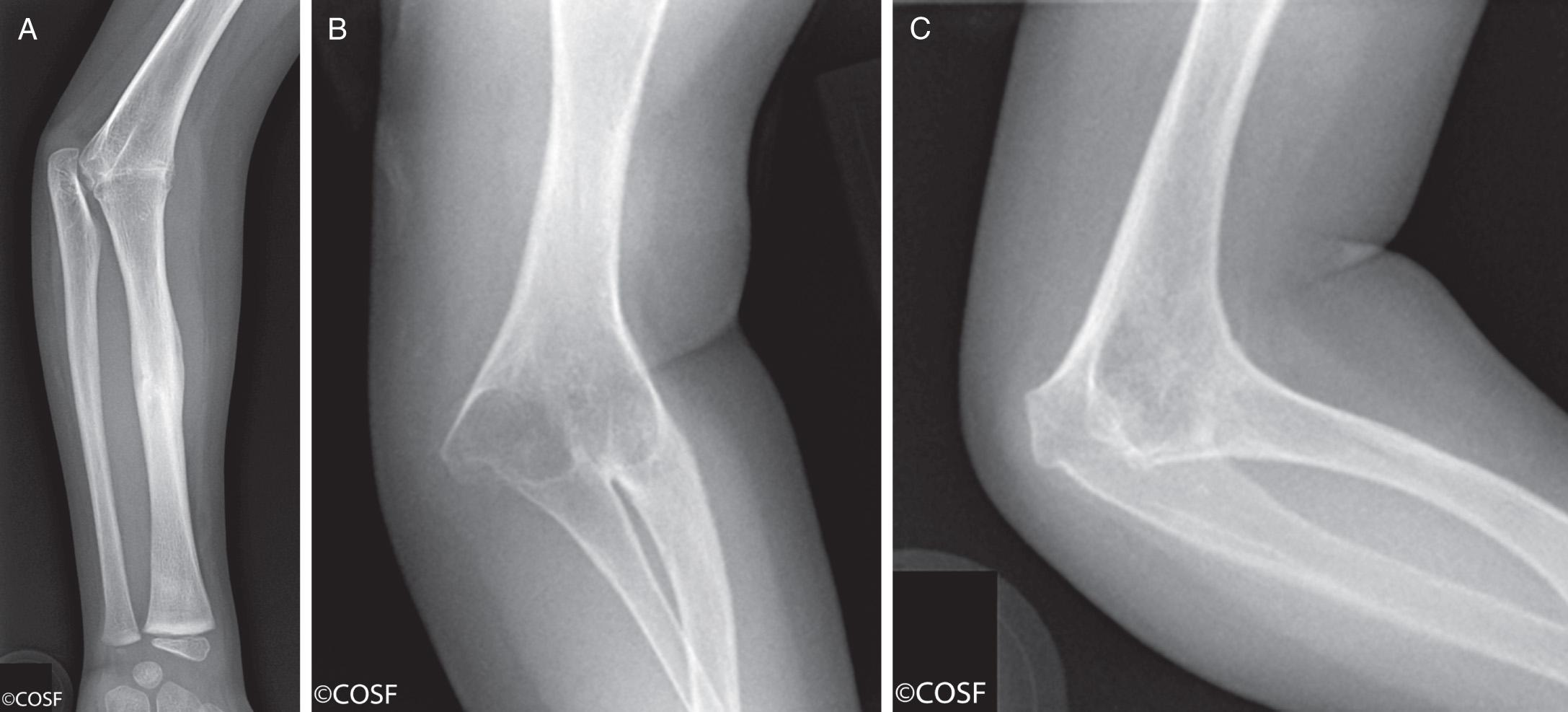
Lorea and colleagues have proposed a classification of ulnar longitudinal deficiency based on a review of their own experience with 46 patients and a literature review that specifically classifies each segment of the upper extremity. They propose three elbow types: type I, normal; type II, radiohumeral synostosis; and type III, radial head subluxation. They further recommend subclassifying the elbows as having extension (type E) or flexion (type F) contractures. Formally, some of these patients were classified as phocomelia ( Fig. 26.9 ); however, on closer study most patients with phocomelia can be classified as more severe forms of radial or ulnar longitudinal deficiency. The Lorea classification helps to focus the need for directed intervention dependent on how the elbow is involved and consequent functional impairment.
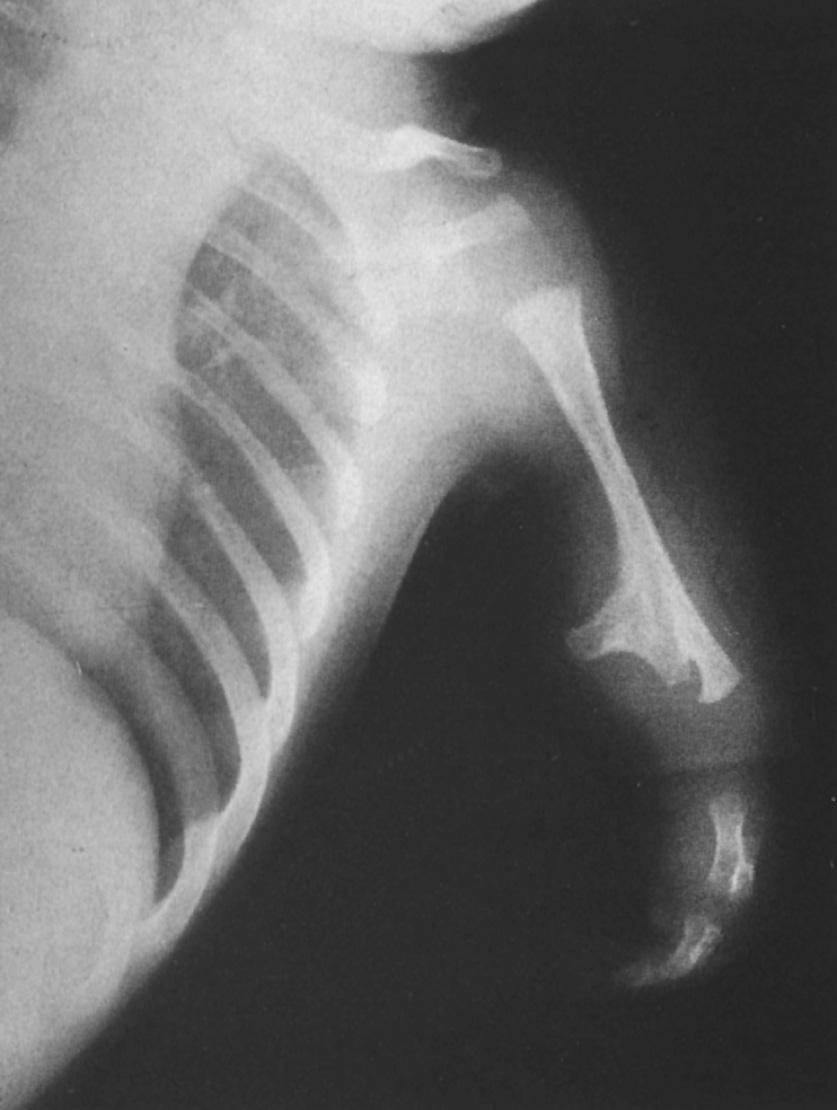
Other causes of joint ankylosis include intrinsic abnormalities of formation of the joint surface. The joint must be formed correctly, must have adequate surface material and ligamentous support. One of the most unusual causes of reduced motion and effective ankylosis of the elbow occurs in ulnar dimelia ( Fig. 26.10 ). The duplicated proximal ulnae articulate with a triangular distal humerus, resulting in severely restricted range of motion (ROM).
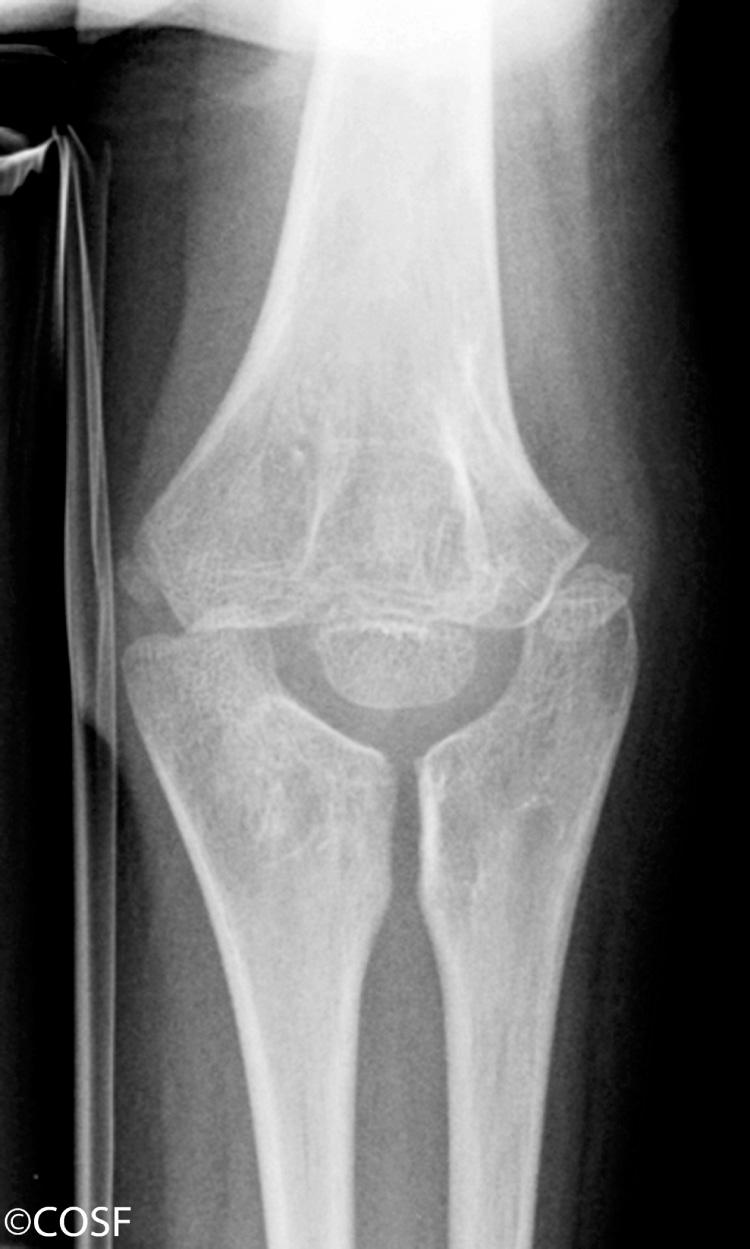
The elbow must also move soon after its formation, or it will become ankylosed, as occurs, for example, in arthrogryposis, pterygium cubitale, or more rarely, Apert syndrome. Patients with secondary dysplasias, such as those with Apert syndrome, may show a progressive loss of motion over time.
Conditions associated with congenital elbow synostosis are numerous. Radioulnar synostosis may be sporadic, familial or associated with syndromic presentations including fetal alcohol syndrome, Holt-Oram and Cenani-Lenz. Holt-Oram is particularly important to consider due to the association with congenital heart defects.
Humeroradial synostosis is most commonly seen with ulnar longitudinal deficiency, but it has also been associated with multiple synostosis syndrome, Pfeiffer syndrome, and Antley-Bixer syndrome. Humeroradioulnar and humeroulnar synostoses are exceedingly rare.
True congenital elbow instability seldom resembles the posttraumatic condition, though the two are sometimes mistaken for each other on initial presentation.
Radial head subluxation or dislocation is the most common problem of instability at the elbow. b
b References .
As discussed earlier, there may be considerable doubt about whether it is congenital, developmental, or posttraumatic.
Subluxations or dislocations in the infant including the common “pulled elbow” after trivial trauma or birth-associated trauma occur if not treated by closed reduction or other means; these deformities may be similar to congenital dislocations of the radial head. In the few cases of known infantile dislocation that have been left untreated but followed, it is suggested that the resulting deformity is milder than that seen in definite congenital hypoplasia at the elbow. By contrast, when traumatic dislocation is unreduced in the older child, the development of the radial head and the capitellum remains fairly normal.
Criteria used to classify a radial head subluxation or dislocation as congenital primarily relates to the morphology of the proximal radius and capitellum. The proximal radius may show underdevelopment with a flat or convex radial head, and the radial neck may be narrow and proximally placed ( Fig. 26.11 ). The capitellum may also be hypoplastic or lack the usual anterior angulation. Absence of the capitellum is probably an example of congenital aplasia; however, hypoplasia of the capitellum may occur after long-standing dislocation from any cause. Bilaterality, especially with symmetric posterior dislocations, it is also more commonly associated with a congenital etiology. However, this is again not an absolute requirement. Approximately half of all patients with isolated congenital radial head dislocation will have a problem bilaterally. Both anterior and lateral congenital dislocations have been reported.
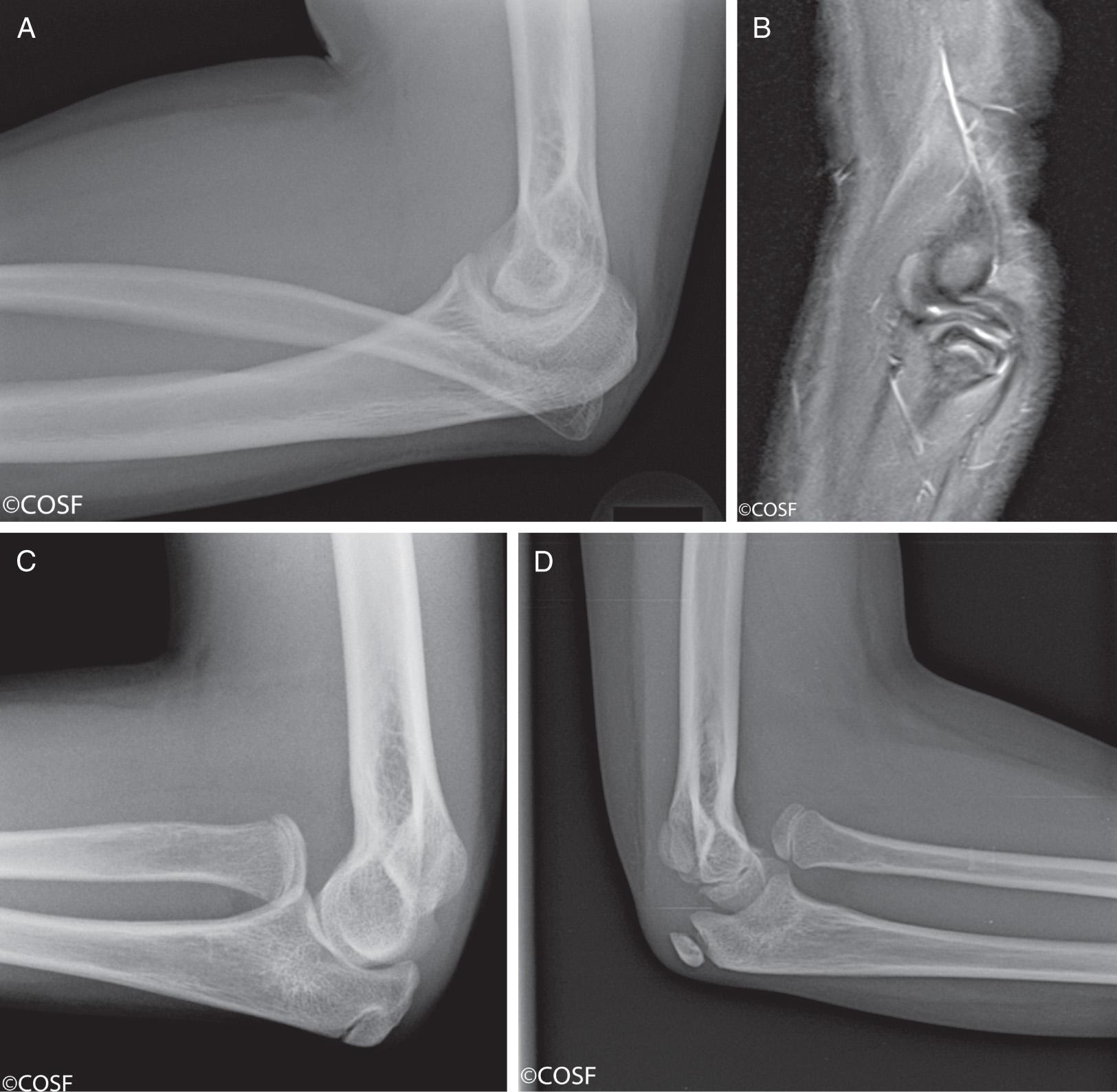
When radial head dislocation is familial, bilateral, or seen at birth, or when it occurs with other musculoskeletal anomalies, particularly anomalies in the same limb, the evidence is strong that the radial head dislocation is congenital.
Bell and associates have classified isolated congenital dislocations of the radial head as type I, subluxation; type II, posterior dislocation with minimal displacement; and type III, posterior dislocation with significant proximal migration of the radius. Type I is the least common dislocation but the one most likely to be associated with pain. Types II and III appear to be roughly equally prevalent. Type III is associated with the most loss of motion, usually supination. Deformity of the radial head without subluxation also has been reported.
Many if not all the features of congenital dislocation can also be seen with developmental dislocation, due to mild degrees of ulnar or capitellar hypoplasia. In such cases the radial head may slowly dislocate with growth, as the paired forearm bones continue to grow at dissimilar rates. Cases that are diagnosed later in life may be associated with a discrepancy in length of the paired forearm bones and, therefore, may fall within the developmental category. It is well known that inadequate length of the ulna from any cause will result in increased compressive stresses along the radius, gradually leading to a subluxation and perhaps a dislocation of the radial head, such as occurs with a loss of forearm balance in multiple hereditary exostosis secondary to ulnar shortening.
Dislocation with severe hypoplasia of the osseous elements of the elbow is the most conclusive congenital instability. Congenital ulnohumeral dislocation is infrequent ( Fig. 26.12 ) except in severe multitissue hypoplasia, such as in severe radial or ulnar longitudinal deficiency ( Fig. 26.13 ), as well as in the pterygium syndromes. The exceedingly rare congenital pseudarthrosis of the olecranon has also been reported.
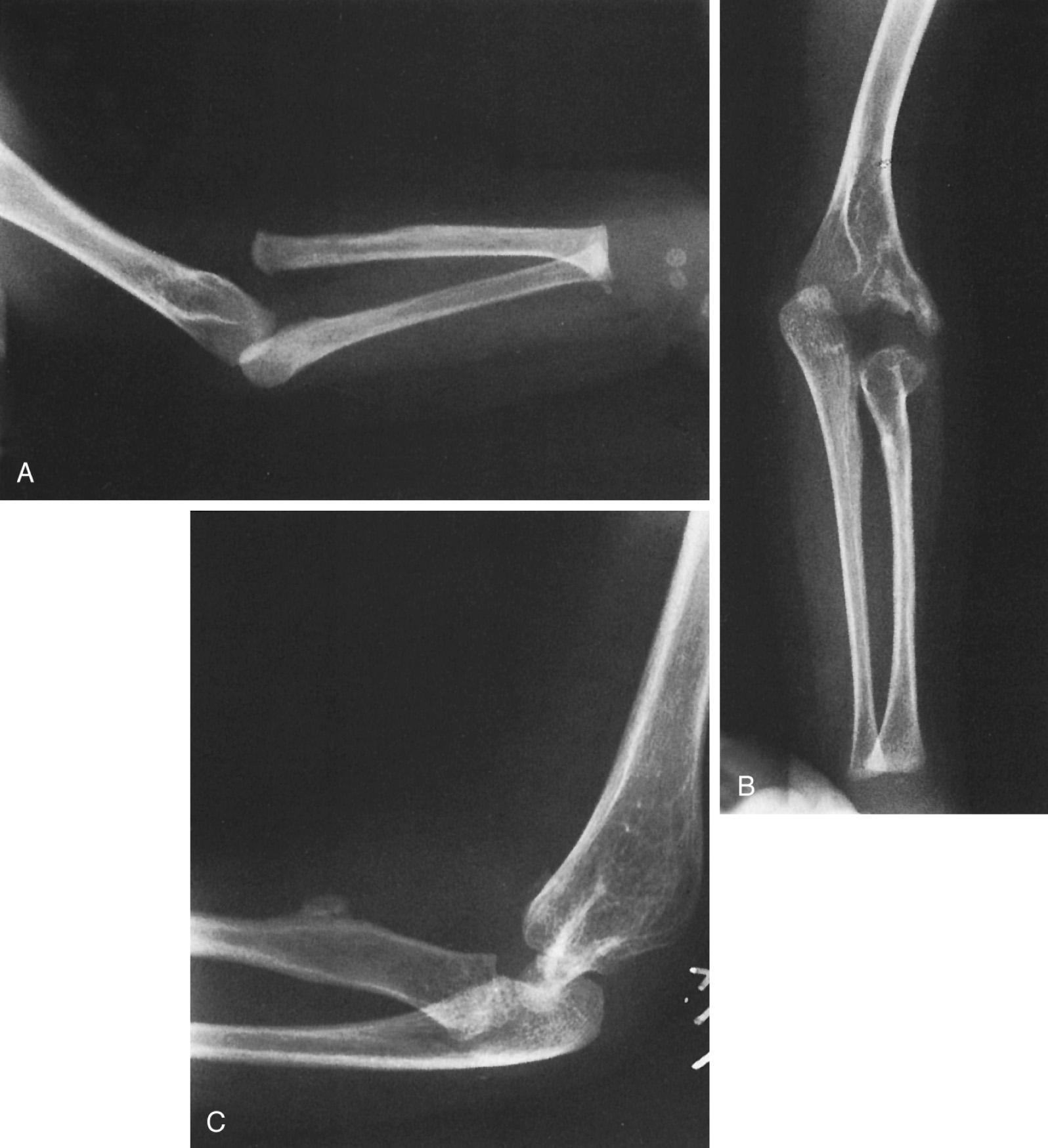
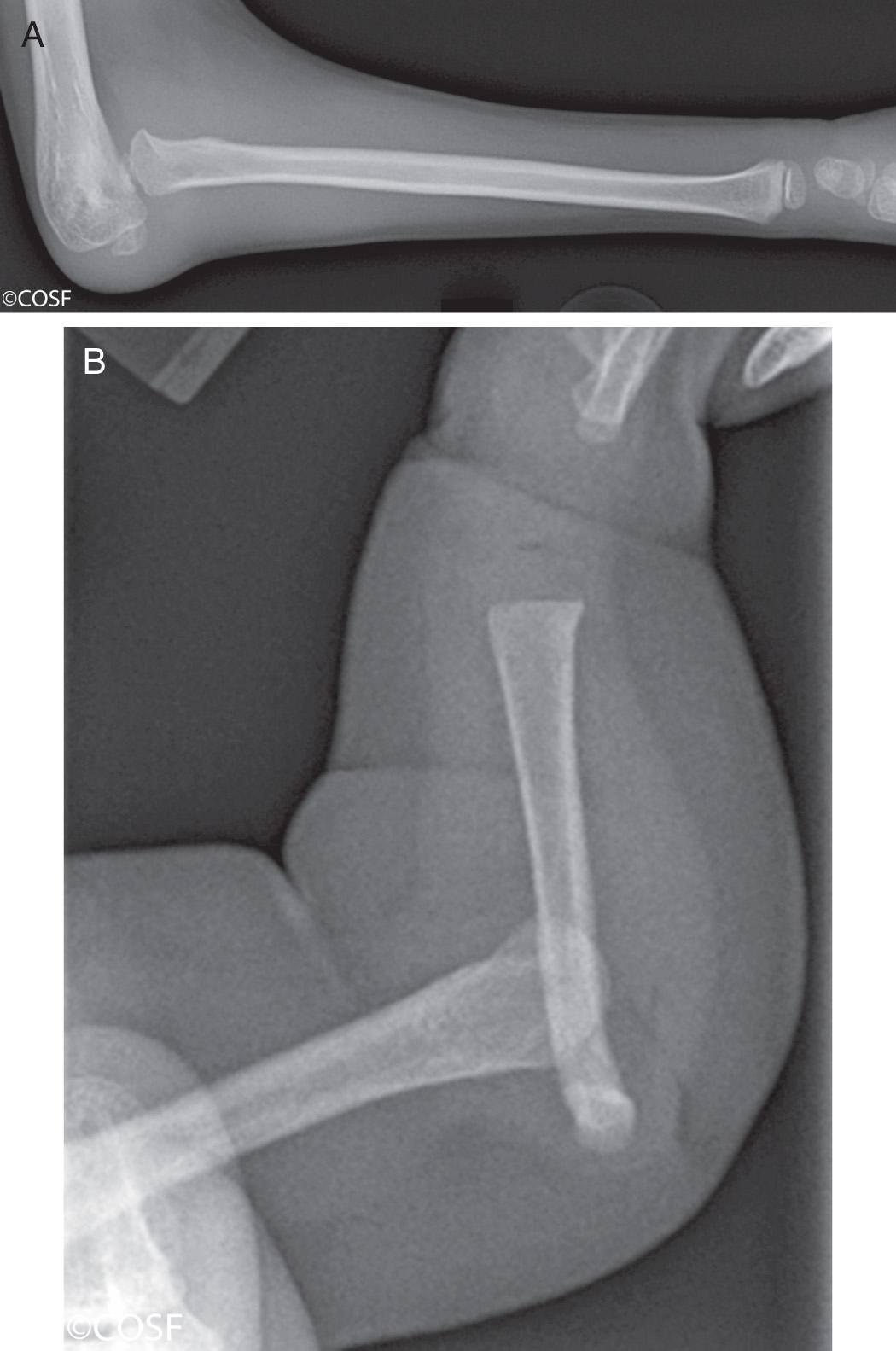
More subtle hypoplasia may lead to secondary problems with the soft tissue structures around the elbow. Murakami reported on hypoplasia of the trochlea and medial epicondyle leading to ulnar neuropathy.
Conditions associated with congenital radial head dislocation are numerous. Congenital radial head dislocation may be isolated, familial, associated with radioulnar synostosis, or a syndromic presentation. There are numerous syndromes associated with congenital radial head dislocation. Some of the more common or important syndromes are nail-patella syndrome, Cornelia de Lange syndrome, Larsen syndrome, Rubinstein-Taybi syndrome, omodysplasia, and variants of multiple epiphyseal dysplasia and spondyloepiphyseal dysplasia. Due to the large number of associations, if concern for a syndromic association with medical implications exists, then genetic consultation may be indicated.
Soft tissue anomalies can be subdivided into generalized syndromes with contractures and neuromuscular deficiencies (arthrogryposis and associated pterygium syndromes, congenital muscular atrophy and myopathy), isolated tissue anomalies (absence or contracture), and congenital soft tissue tumors.
Arthrogryposis and its related syndromes are included in this group. Both amyloplasia and distal arthrogryposis may present with elbow involvement. Amyloplasia characteristically results in an elbow extension contracture with an absence of biceps function, although the ROM and posture are variable.
The classic malformation with flexion contracture is pterygium cubitale, in which almost every soft tissue is abnormal and a severe contracture exists. This is one manifestation of congenital multiple pterygium syndrome that may affect the neck, axilla, elbow, knee, or digits. The elbow has been reported to be affected in 12% of cases. The anterior skin web may be unilateral or bilateral, symmetric or asymmetric. Associated abnormalities involving almost every body system have been reported.
Another condition resulting in formidable contractures about the elbow is fibrodysplasia ossificans progressiva. This is a rare autosomal dominant disease, with ectopic ossification commencing in early childhood.
Muscle, nerve, vascular, and lymphatic anomalies in the region of the elbow are not uncommon.
The anconeus epitrochlearis occasionally is present as an anomalous muscle and may cover the ulnar nerve in the cubital tunnel, contributing to possible entrapment. Other anomalous muscles that may cause compressive neuropathies are (1) an anomalous head of the flexor pollicis longus (Gantzer muscle) or flexor profundus that usually originates from the medial epicondyle or the coronoid process of the ulna and occasionally may cause anterior interosseous nerve compression; (2) a solitary head of the supinator; (3) accessory muscles of the anterolateral aspect of the elbow, including the accessory brachialis or accessory brachioradialis; (4) variations in the head, origin, or insertion of the pronator teres; (5) variations of in the flexor carpi radialis, the flexor carpi ulnaris, and the palmaris longus; and (6) an aberrant medial head of the triceps, which may snap over the medial epicondyle and irritate the ulnar nerve.
Become a Clinical Tree membership for Full access and enjoy Unlimited articles
If you are a member. Log in here